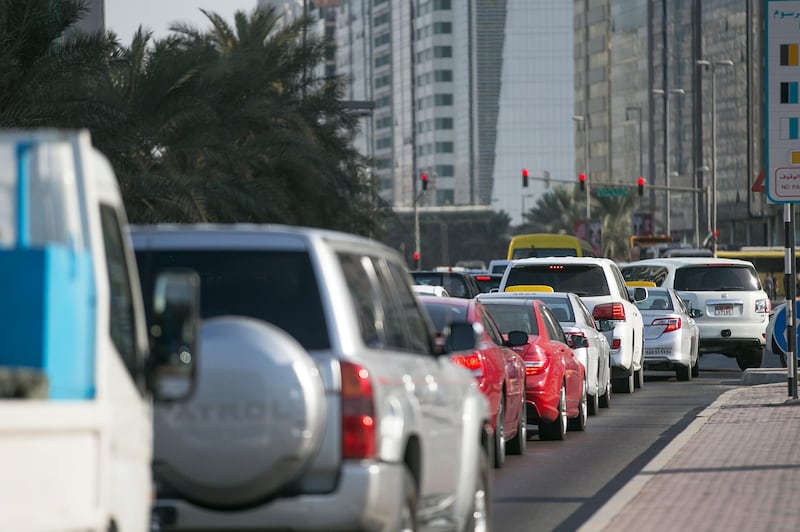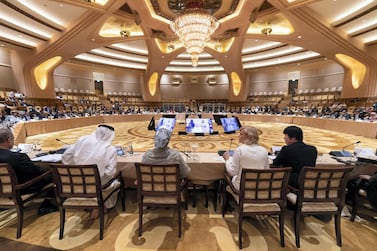Rapid increases in population and economic growth have been contributed to causing a rise in greenhouse gas emissions in Abu Dhabi.
The results of a major study by a government agency, released on Monday, showed that the release of harmful gases such as carbon dioxide into the atmosphere had risen by 36.6 per cent between 2010 and 2016, an average rise of more than six per cent per year.
Per capita, Abu Dhabi’s carbon dioxide emissions are among the highest in the world, although the emirate is responsible for less than 0.3 per cent of global emissions, which are a leading cause of climate change.
Internationally, Abu Dhabi compares more favourably on other measures, such as carbon intensity of electricity production, although it remains slightly above global averages.
It is hoped that a series of government-backed initiatives, most notably the new Barakah nuclear power station, will see emissions stabilise over the next decade and break the link between demographic and economic growth and pollution.
Experts said they believed it was possible to drive down emissions while still continuing to expand the Abu Dhabi population and economy.
Dr Thani Al Zeyoudi, Minister for Environment and Climate Change, said plans have been put in place to lower carbon emissions.
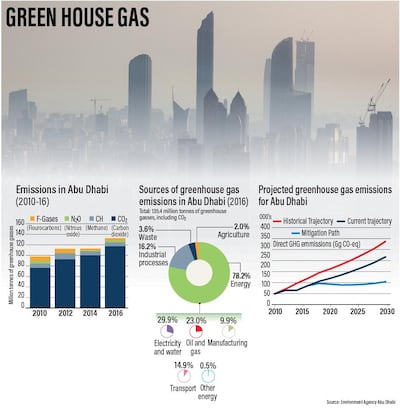
“The UAE has embarked on a journey towards a low-carbon, green economy, guided by the UAE Green Growth Strategy that seeks to make economic development in the country more environmentally sustainable,” Dr Al Zeyoudi said.
Reacting to the findings, Patricia Espinosa, executive secretary of the United National Framework Convention on Climate Change, praised a focus on tackling climate change in the UAE and the publication of the data.
“I am pleased to hear you have already initiated work that assumes a greater share of renewable energy, more measures for energy efficiency and decarbonisation of the transport sector,” she said, in a video message played at a launch event for the report.
“At the same time, we know that the progress for mitigation and adaptation has not been uniform across all members of the UAE. We must remember that no one can be left behind in our urgent and collective task to address climate change while we still can.
“I would like to congratulate the Abu Dhabi Environment Agency for its concerted efforts towards climate action. We encourage you to keep and speed up the good work and we look forward to supporting these efforts in the future.”
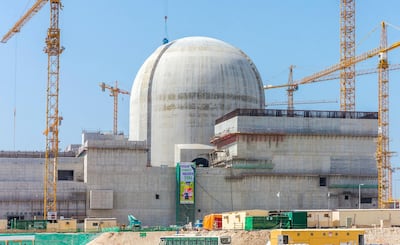
The figures were released as part of the third Abu Dhabi Greenhouse Gas Emissions Inventory, which updates baseline emissions and projections up to 2030. The figures are used to judge performance against international commitments such as the Paris Climate Agreement.
In a report, the Environment Agency Abu Dhabi set out three scenarios for future emissions. If the historic trajectory, or ‘business as usual’ based on the latest figures are followed, emissions will continue to soar.
However, under a third scenario, the ‘mitigation path’, emissions will remain stable up to 2030. This model takes into account policies already under way or announced. These include the new nuclear power station, more renewable energy, a transport master plan and a carbon capture and storage project.
Energy, taking into account sectors such as electricity and water; oil and gas; and manufacturing, accounted for 78.2 per cent of the 135.4 million tonnes of greenhouse gas emissions estimated in 2016. Industrial processes accounted for 16.2 per cent, waste for 3.6 per cent and agriculture 2 per cent.
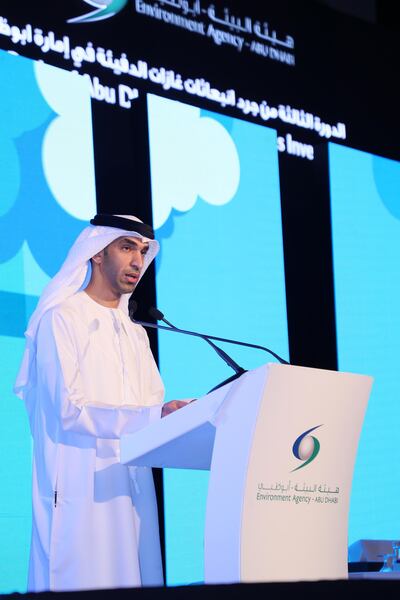
Between 2010 and 2016, the population of Abu Dhabi emirate — including Al Ain and Al Dhafra — rose from 2.1 million people to 2.9 million, according to Statistics Centre Abu Dhabi. Abu Dhabi city region's population rose from about 1.26 million to 1.8 million.
Last month, the Abu Dhabi government said it would slash energy bills for industrial businesses, if they could show they have a "very efficient" use of power.
He said the ministry is working with local authorities "develop a comprehensive inventory map of greenhouse gas sources and concentrations across the UAE with the aim of identifying emission hotspots and supporting mitigating actions".
The string of new environmentally-friendly projects being rolled out have the potential to break the link between population increases, economic growth and higher emissions, according to Hussein Hamed, a climate change scientist at the agency.
“We see through our greenhouse gas inventories for previous years that emissions are increasing consistently in line with the population growth and economic development,” he said. “But we expect that [in future] emissions will be reduced even though economic development and the population will continue to increase.
“Emissions will reduce after the operation of the first nuclear reactor and with expansion and implementation of renewable energy power plants. The greenhouse gas emissions, and the GDP, will see a decoupling. So they will not go in line with each other.”
The Abu Dhabi government has a series of targets aimed at reducing emissions, alongside UAE-wide commitments to international agreements aimed at tackling climate change.
It is planned that clean energy will contribute 27 per cent of the UAE's total energy mix by 2021, with this set to rise to 50 per cent by 2050. Other policies being rolled out in Abu Dhabi include a sustainable waste management programme, initiatives to encourage businesses to use water and electricity more efficiently and an energy efficiency programme for the production of aluminium, oil and gas.
The 2021 national target remains within reach, said Shaikha Al Hosani, executive director of the environment quality sector at the Abu Dhabi Environment Agency, although much rests on whether the new nuclear power station will be ready on time. Currently, it is due to come on stream next year.
“Rapid increase in population came hand in hand with increased demand for water and energy,” she said. “This was the main driver for the greenhouse gas emissions, as well as rapid economic growth in various fields.
“Hopefully, with the operation of the nuclear reactor, we are going inshallah to achieve the [2021] target, but it all depends on the operation of the nuclear plant.”
Water needs and oil industry all drive emissions
Water desalination, as well as oil and gas extraction and processing, are among the leading causes of greenhouse gas emissions in the UAE. Both demand for water and energy, officials said, was driven by a rise in demand caused by a buoyant economy, a rapid pace of development and demographic growth. Water desalination, the process of making seawater drinkable, is a notoriously energy-intensive process.
While emissions rose by 36.6 per cent between 2010 and 2016, Abu Dhabi’s population rose by 38.9 per cent and GDP rose by 34.5 per cent. Environment Agency Abu Dhabi said this showed growth in the economy and the population had grown almost “hand in hand” with rising emissions.
Carbon dioxide, or CO2, accounted for the vast majority, 89 per cent, of the emissions. CO2 from the energy industry accounted for more than half of all emissions, with road vehicles contributing a further 13.4 per cent.
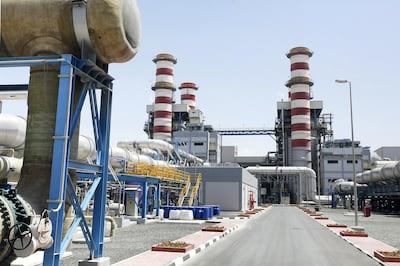
Other greenhouse gases emitted in significant quantities include methane, a by-product of the waste disposal industry, as well as oil and gas.
The third cycle of greenhouse gas data, recorded every two years against a baseline set in 2010, includes data collected from a variety of sources. Authorities and agencies in various sectors helped by providing figures, which were cross-checked and analysed with other data sources.
Any data gaps were resolved by making “justified assumptions”. They were collated in line with guidelines provided by the Intergovernmental Panel on Climate Change, which is a UN organisation. Abu Dhabi is one of the first places to incorporate new guidelines relating to wetlands.
Under the Kyoto Protocol, an international climate treaty adopted in 1997 and coming into force in 2005, the UAE must provide greenhouse gas inventories to the United Nations Framework Convention for Climate Change. The figures released yesterday will also be used to judge the UAE’s performance against other obligations, such as the Paris Agreement.
In future reports, it is proposed that a “live data acquisition system”, which would include greenhouse gas figures, is established.
